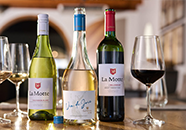
“The winter before the harvest has an important role to play in the eventual quality of wine grapes. We need cold for decent dormancy and rain to replenish the water levels. Last year, we received both”, says La Motte cellar master, Edmund Terblanche.
Rain:
With a very wet winter and around 35% more rain than the long term average, underground water has been replenished and this year water has not been too much of a concern. Even the Walker Bay area that suffered a 2-year dry spell had enough rain to last the season. The last drenching rains fell mid-October and although a dry and warm December and January caused worries about soil humidity, the late rains ensure that vineyards were coping with the heat and windy conditions. The dry conditions were positive to keep diseases at bay and to ensure optimal flowering.
On 9 February we had some thorough downpours which interrupted the harvest for a few days. Although some areas had problems after the rain, Franschhoek did not suffer too much and the rain was positive for late cultivars like Cabernet Sauvignon. The rain also replenished soil moisture and water resources can now be used for post-harvest irrigation.
Temperature:
An exceptionally cold winter ensured ample cold units. Spring was mild to cool with more rain which was initially thought to postpone the season with about two weeks. Budding was proportionate and strong due to the good cold season and water levels.
But we also had heat. Not necessarily continuous heat waves, but according to Vinpro, the average temperature in December was the highest in 48 years. While enough foliage protecting vines, there was surprisingly little heat damage. Heat conditions also accelerated ripening and the season was not as late as initially expected.
January and February temperatures were mild and especially night temperatures were noticeably lower than usual. Ripening was gradual which made it easier to plan the harvest.
Wind:
Gale force South Eastern winds during November and December caused some damage to vines. Although shoot damage in areas such as Bot River is a reality, the harm was not more than expected for natural windy areas.
Wind damage to vines has resulted in a downward adjustment in crop estimates but windy conditions during ripening did prevent diseases and ensure healthy grapes.
Strong winds have dried out the soil, but good dam levels and the February rains ensured enough water for supplementary irrigation.
Volume:
Vinpro and winemakers in the Western Cape predicted the harvest to be very similar in volume to 2012, with the possibility of a slight increase. SAWIs’s Wine Industry Information forecasted a slight decrease of 0.4% on the 2012 vintage – largely caused by the strong winds at the end of 2012.
In general the volumes are different in various areas. On La Motte we harvest slightly more Sauvignon Blanc than last year, but in Stellenbosch the Sauvignon Blanc volumes are definitely down. We also harvested more Merlot and Shiraz in Paarl and Franschhoek than in 2012.
Quality:
Quality seems to be exceptional with especially low pH measurements and very good colour. Aromas are also intense and characteristic.
In Franschhoek, some late ripening, higher yielding blocks in sandy soil such as Shiraz, Grenache, Carignan and Mouverde struggled with sugar and colour.
Agriculture in the Western Cape can do with some positive energy and in the wine industry in general, there is a positive anticipation about the quality of the 2013 wine grape harvest.
#WineTalk
#Harvest












